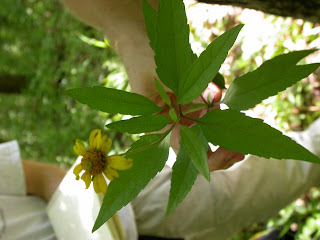
Yesterday, I had the opportunity to study in the field two of Michigan's rarest plant species. Hall's bulrush (Schoenoplectus hallii) is a globally imperiled species with a mostly Midwestern distribution, occurring on drawn-down sandy pondshores and other similar habitats, including seasonally wet agricultural fields. In Michigan, this species is found exclusively in a habitat we call coastal plain marsh, which occurs in shallow depressions or the margins of precipitation-fed, isolated ponds and lakes on broad, sandy outwash plains or lakeplain in southwestern Lower Michigan. It is always associated with coastal plain disjuncts, many of which are also rare in the state. The interesting thing about Hall's bulrush is its peculiar germination biology. The timing, frequency, and amount of precipitation over the year must be just right in order for seed germination to occur. Decades can pass between appearances of Hall's bulrush in any given site. This year, conditions were favorable for this species to germinate and appear above ground for the first time since 2002. Most plants were quite small (3-4") and senescing due to the late summer drought we are experiencing.
An even rarer (in Michigan) species occurring with Hall's bulrush in Michigan is the dwarf burhead, Echinodorus tenellus.

This tiny annual member of the Alismataceae was first collected in Michigan during the First Geological Survey, in 1837, near White Pigeon in St. Joseph County. Amazingly, after 152 years, it was rediscovered in Michigan in 1989 at the Allegan State Game Area, in the same area occupied by Hall's bulrush. It has a preference for low, wet spots within shallow depressions that support coastal plain marsh or wet-mesic sand prairie dominated by Panicum virgatum and Spartina pectinata. These areas are saturated or shallowly inundated during a portion of the growing season, and are free from significant vegetative competition. Most of these low, wet spots were created by ORV use in these wetlands, a type of disturbance that is noted as a threat to these systems yet one that creates microhabitats colonized by dwarf burhead, Hall's bulrush, and a variety of other tiny annuals that find refuge in the compacted, wet, bare areas created by ORV activity.
Do these rare species owe, in part, their continued presence in Michigan due to human disturbances to their habitats? Funny how the most obscure, nondescript members of our flora have so much to tell us about ecology, conservation, and management.

























